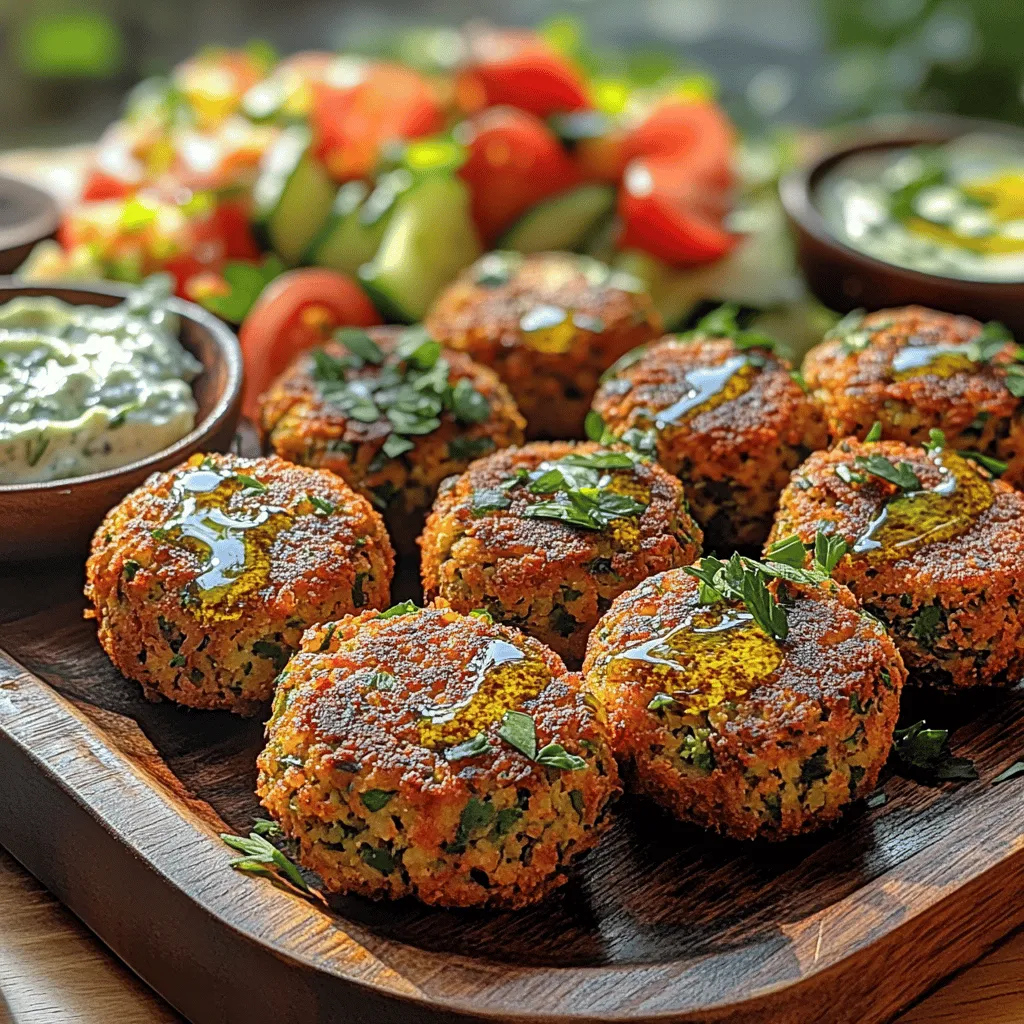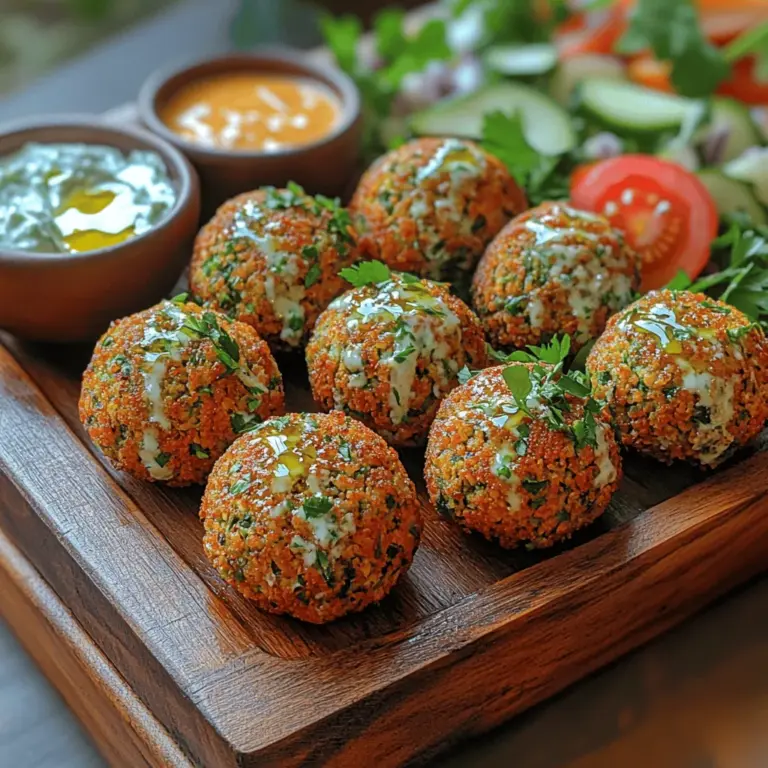Introduction
Falafel is a beloved dish that has transcended its Middle Eastern origins to become a staple in vegetarian and vegan cuisine worldwide. These small, deep-fried balls of ground chickpeas, herbs, and spices have captured the hearts—and appetites—of many, thanks to their unique flavor profile and satisfying texture. As the global trend towards plant-based diets continues to rise, falafel has gained even more popularity as a delicious and nutritious option for those seeking meatless meals.
In this article, we are excited to introduce you to our Crunchy Baked Falafel Balls recipe. This version offers all the classic flavors of traditional falafel but with a healthier twist. By baking instead of frying, you can enjoy a crispy exterior and a fluffy interior without the added calories and fat associated with frying. Not only do baked falafel balls deliver on taste, but they also provide numerous nutritional benefits thanks to their wholesome ingredients.
Chickpeas, the star ingredient in falafel, are known for their impressive nutritional profile. They are high in protein and fiber, making them an excellent choice for those looking to increase their intake of plant-based nutrients. Additionally, the fresh herbs and spices used in this recipe, such as parsley, cilantro, cumin, and coriander, not only enhance the flavor but also contribute to the overall health benefits of the dish.
Understanding Falafel
The history of falafel is a fascinating journey that reflects the rich culinary traditions of the Middle East. While the exact origins of falafel are hotly debated, it is widely believed that these savory balls were first made in Egypt, where they were traditionally crafted from fava beans. Over time, falafel spread throughout the region, evolving into the chickpea-based version that is now popular globally.
Each culture has its own take on falafel, with variations in ingredients and preparation methods. In some regions, falafel is served in pita bread with fresh vegetables and sauces, while in others, it may be enjoyed as part of a meze platter. Regardless of its form, falafel remains a symbol of Middle Eastern cuisine and hospitality.
From a nutritional standpoint, falafel is a powerhouse of health benefits. Chickpeas, the main ingredient, are not only rich in protein but also packed with dietary fiber, which aids digestion and promotes a feeling of fullness. This makes falafel an ideal option for those looking to maintain a healthy weight or incorporate more plant-based foods into their diet.
Fresh herbs such as parsley and cilantro add a burst of flavor while also providing essential vitamins and minerals. Parsley is known for its high levels of vitamin K, while cilantro boasts antioxidant properties that can help combat inflammation. The spices used in falafel, particularly cumin and coriander, not only contribute to its distinctive taste but also offer additional health benefits. Cumin is known to aid digestion, while coriander has been linked to lower cholesterol levels.
Ingredients Breakdown
To create the perfect Crunchy Baked Falafel Balls, it’s essential to choose high-quality ingredients that enhance both the flavor and nutritional value of the dish. Here’s a detailed look at each component:
– Chickpeas: When it comes to chickpeas, you have the option of using canned or dried beans. Canned chickpeas are convenient and save time, while dried chickpeas require soaking and cooking but can offer a fresher taste. If you choose dried chickpeas, be sure to soak them overnight for optimal texture.
– Fresh Herbs: Fresh parsley and cilantro are crucial for achieving the vibrant flavor profile that falafel is known for. While dried herbs can be used in a pinch, using fresh herbs elevates the dish significantly, contributing both taste and nutritional benefits.
– Spices: The spices in falafel are what make it truly special. Cumin and coriander are essential for imparting warmth and depth of flavor. These spices also have their own health benefits, such as anti-inflammatory properties and digestive support.
– Tahini: This creamy paste made from ground sesame seeds adds a rich, nutty flavor to the falafel mixture. Tahini is not only delicious but also packed with healthy fats, vitamins, and minerals.
– Breadcrumbs: To achieve that crunchy texture while keeping the recipe healthy, you can use breadcrumbs. Opt for whole wheat or gluten-free breadcrumbs depending on your dietary needs. These will help bind the falafel mixture while adding a satisfying crunch.
– Optional Ingredients: For those who like a bit of heat, adding cayenne pepper can give your falafel an extra kick. This spice not only enhances flavor but may also boost metabolism and provide additional health benefits.
Preparing Your Crunchy Baked Falafel Balls
Now that we’ve covered the background and ingredients, let’s move on to the preparation of your Crunchy Baked Falafel Balls. The process is straightforward and involves a few key steps to ensure that your falafel turns out perfectly crispy and flavorful.
1. Preheat the Oven: Start by preheating your oven to 400°F (200°C). This will ensure that your falafel balls cook evenly and develop a nice crunch.
2. Prepare the Chickpeas: If you’re using dried chickpeas, make sure they have soaked overnight and are cooked until tender. For canned chickpeas, drain and rinse them thoroughly to remove excess sodium.
3. Combine Ingredients: In a food processor, combine the chickpeas, fresh herbs, garlic, tahini, and spices. Pulse the mixture until it is well-combined but still slightly chunky. This texture is important for achieving the right bite in your falafel.
4. Add Breadcrumbs: Transfer the mixture to a bowl and fold in the breadcrumbs until everything is well incorporated. The breadcrumbs will help bind the mixture, making it easier to form into balls.
5. Shape the Falafel: Using your hands, shape the mixture into small balls or patties, ensuring they are compact. This will help them hold their shape during baking.
6. Bake the Falafel: Place the formed falafel balls on a baking sheet lined with parchment paper. Lightly brush or spray them with olive oil to enhance browning. Bake for about 25-30 minutes, flipping halfway through, until they are golden brown and crispy on all sides.
By following these steps, you’ll be well on your way to enjoying a plate of delicious, Crunchy Baked Falafel Balls. Whether served in a pita, on a salad, or as a snack, these falafel balls are sure to please both plant-based enthusiasts and meat-lovers alike.

Importance of Properly Prepping Chickpeas
When it comes to making the perfect falafel, the preparation of the chickpeas is crucial. If you’re using canned chickpeas, it’s essential to drain and rinse them thoroughly to remove excess sodium and preservatives. While canned options are convenient, for the best texture and flavor, soaking dried chickpeas overnight is recommended. This process hydrates the beans and helps achieve a better consistency in the final product. The soaked chickpeas also hold together better when blended, allowing for a crunchier outer layer once baked.
To soak dried chickpeas, simply cover them with water and let them sit for at least 8 hours or overnight. After soaking, drain and rinse them before incorporating them into your falafel mix. This step is vital as it ensures the chickpeas are tender and ready to absorb the flavors of your spices and herbs.
Combining Ingredients: Texture and Consistency Tips
Once your chickpeas are prepped, the next step is to combine them with your other ingredients. For the ideal falafel consistency, it’s important to achieve a balance between wet and dry ingredients. In addition to chickpeas, you’ll typically include garlic, onion, fresh herbs (like parsley and cilantro), and spices such as cumin and coriander.
When mixing these ingredients, consider the following tips for the best texture:
– Pulse, Don’t Blend: Use a food processor to pulse the ingredients instead of blending them into a smooth paste. This helps maintain some texture, which is essential for a crunchy falafel.
– Check Consistency: After mixing, the mixture should hold together when formed into a ball but should not be overly wet. If it’s too crumbly, you can add a small amount of water; if it’s too wet, incorporate more breadcrumbs.
– Let It Rest: Allowing the mixture to rest for about 30 minutes in the refrigerator helps the flavors meld and the mixture firm up, making it easier to shape.
The Role of Breadcrumbs in Achieving the Perfect Falafel Texture
Breadcrumbs play a significant role in achieving that coveted crunchy texture in your baked falafel. They help bind the mixture while absorbing moisture, which contributes to a crispy outer layer during baking. When selecting breadcrumbs, consider using panko, as it is coarser and can provide a greater crunch compared to traditional fine breadcrumbs.
For a gluten-free option, you can substitute regular breadcrumbs with gluten-free breadcrumbs or ground oats. Just be sure to adjust the quantity, as different binders may absorb moisture differently. Start with a smaller amount and gradually add more until the mixture holds together nicely.
Shaping Falafel: Techniques for Uniformity and Cooking
Shaping your falafel is another step that can impact your final result. To ensure even cooking and a consistent texture, aim for uniform balls or patties. Here are some techniques to help:
– Use a Cookie Scoop: A small cookie scoop can help you portion out the mixture evenly. This tool not only ensures uniform size but also keeps your hands clean.
– Wet Your Hands: Dipping your hands in water or oil before shaping the falafel can prevent sticking and make it easier to form perfect balls.
– Flatten for Even Cooking: While traditional falafel are round, flattening them slightly into patties can help them cook more evenly in the oven, creating a larger surface area for that desired crunch.
Baking the Falafel
Baking falafel is a healthier alternative to frying and allows you to enjoy all the flavor with less oil. Here’s how to ensure your baked falafel turns out perfectly:
Explanation of the Baking Process vs. Frying
Baking falafel provides a lighter dish without sacrificing flavor. Unlike frying, which can add excess oil and calories, baking allows the ingredients to shine through while still achieving a satisfying crunch. The key is to create a hot environment that crisps up the exterior while keeping the inside moist.
Importance of Preheating the Oven and Its Impact on Texture
Preheating the oven is a crucial step in baking falafel. A hot oven ensures that the falafel begin to crisp up immediately upon entering, preventing them from becoming soggy. Set your oven to 400°F (200°C) and allow it to preheat fully before placing your falafel on a baking sheet.
Drizzling Olive Oil: How It Contributes to Crunchiness
To enhance the crunchiness of your baked falafel, drizzle a little olive oil over them before baking. This small addition not only helps achieve a golden crust but also adds a rich flavor. Use a brush or your hands to lightly coat each falafel ball with oil, ensuring even coverage.
Baking Time and Tips for Achieving Golden Brown Perfection
Bake your falafel for about 20-25 minutes, flipping them halfway through to ensure even browning. Keep an eye on them; you want them to be golden brown and firm to the touch. If you desire extra crispiness, you can turn on the broiler for the last couple of minutes—just watch closely to prevent burning.
Serving Suggestions
Falafel is incredibly versatile and can be served in various delicious ways. Here are some ideas to elevate your meal:
Ideas for Dipping Sauces
Pair your crunchy baked falafel with dipping sauces that complement their flavors. Consider these options:
– Tahini Sauce: A classic pairing, tahini sauce adds a creamy, nutty flavor. Mix tahini with lemon juice, garlic, water, and salt to taste for a simple and delicious sauce.
– Tzatziki: This refreshing yogurt dip is made by combining Greek yogurt, grated cucumber, garlic, dill, lemon juice, and salt. It adds a cool contrast to the warm falafel.
Pairing Falafel with Salads and Wraps
Falafel pairs wonderfully with fresh salads or wraps for a complete meal. Here are a few serving suggestions:
– Falafel Salad: Create a vibrant salad with mixed greens, tomatoes, cucumbers, and red onions. Top with your favorite dressing and a few falafel balls for a satisfying meal.
– Falafel Wrap: Wrap falafel in pita bread with lettuce, tomatoes, and a drizzle of tahini or tzatziki for a quick and delicious lunch option.
Creative Ways to Incorporate Falafel into Meals
Don’t be afraid to experiment with falafel! Here are a couple of creative ideas:
– Falafel Bowl: Layer falafel in a bowl with quinoa or rice, roasted vegetables, and a dollop of your favorite sauce for a hearty bowl meal.
– Falafel Sliders: Make mini falafel patties for sliders, topping them with pickled vegetables and spicy mayo for a fun appetizer.
Storing and Reheating Falafel
If you find yourself with leftover falafel, proper storage and reheating can help maintain their crunchiness.
Best Practices for Storing Leftover Falafel
Store leftover falafel in an airtight container in the refrigerator for up to 4 days. To keep them from getting soggy, separate layers with parchment paper.
Tips for Reheating to Maintain Crunchiness
To reheat falafel while keeping them crispy, place them in a preheated oven at 375°F (190°C) for about 10 minutes. This method helps revive their crunch without drying them out.
Freezing Falafel for Meal Prep: How to Do It Right
For longer storage, you can freeze falafel before or after baking. To freeze before baking, shape the falafel and place them on a baking sheet to freeze individually. Once frozen, transfer them to a freezer bag for up to 3 months. When ready to bake, you can cook them straight from frozen; just add a few extra minutes to the baking time. If freezing after baking, ensure they cool completely before placing them in an airtight container.
Conclusion
Making Crunchy Baked Falafel Balls at home offers not just a tasty meal but a multitude of health benefits. Packed with protein and fiber from chickpeas, they are a nutritious alternative to meat-based dishes. The versatility of falafel means you can enjoy them in various ways, whether in a salad, wrap, or on their own with a dipping sauce.
Encouraging creativity in the kitchen is essential; don’t hesitate to experiment with different herbs, spices, and serving options to tailor the dish to your taste. With the right preparation and techniques, you’ll soon master the art of making delicious, crunchy baked falafel that will impress family and friends alike. Enjoy the journey of flavor and health with every bite!

